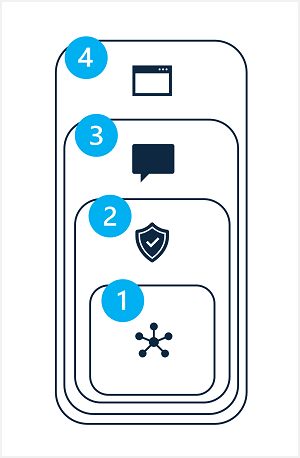Mitigate potential harms
After determining a baseline and way to measure the harmful output generated by a solution, you can take steps to mitigate the potential harms, and when appropriate retest the modified system and compare harm levels against the baseline.
Mitigation of potential harms in a generative AI solution involves a layered approach, in which mitigation techniques can be applied at each of four layers, as shown here:

- Model
- Safety System
- Metaprompt and grounding
- User experience
1: The model layer
The model layer consists of the generative AI model(s) at the heart of your solution. For example, your solution may be built around a model such as GPT-4.
Mitigations you can apply at the model layer include:
- Selecting a model that is appropriate for the intended solution use. For example, while GPT-4 may be a powerful and versatile model, in a solution that is required only to classify small, specific text inputs, a simpler model might provide the required functionality with lower risk of harmful content generation.
- Fine-tuning a foundational model with your own training data so that the responses it generates are more likely to be relevant and scoped to your solution scenario.
2: The safety system layer
The safety system layer includes platform-level configurations and capabilities that help mitigate harm. For example, Azure OpenAI Service includes support for content filters that apply criteria to suppress prompts and responses based on classification of content into four severity levels (safe, low, medium, and high) for four categories of potential harm (hate, sexual, violence, and self-harm).
Other safety system layer mitigations can include abuse detection algorithms to determine if the solution is being systematically abused (for example through high volumes of automated requests from a bot) and alert notifications that enable a fast response to potential system abuse or harmful behavior.
3: The metaprompt and grounding layer
The metaprompt and grounding layer focuses on the construction of prompts that are submitted to the model. Harm mitigation techniques that you can apply at this layer include:
- Specifying metaprompts or system inputs that define behavioral parameters for the model.
- Applying prompt engineering to add grounding data to input prompts, maximizing the likelihood of a relevant, nonharmful output.
- Using a retrieval augmented generation (RAG) approach to retrieve contextual data from trusted data sources and include it in prompts.
4: The user experience layer
The user experience layer includes the software application through which users interact with the generative AI model as well as documentation or other user collateral that describes the use of the solution to its users and stakeholders.
Designing the application user interface to constrain inputs to specific subjects or types, or applying input and output validation can mitigate the risk of potentially harmful responses.
Documentation and other descriptions of a generative AI solution should be appropriately transparent about the capabilities and limitations of the system, the models on which it's based, and any potential harms that may not always be addressed by the mitigation measures you have put in place.